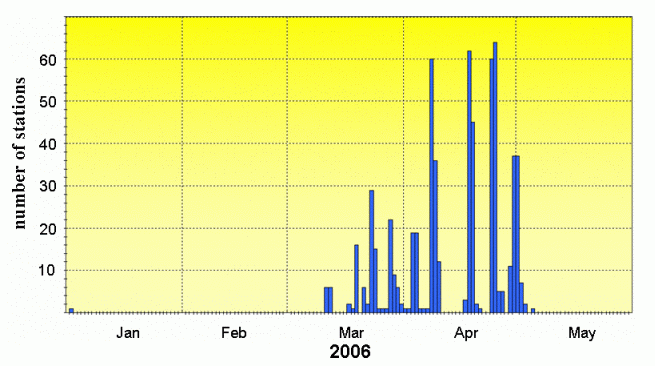 |
The total number of days of yellow sand, which is the aeolian dust transported from the Asian continent, observed in Japan was 42 during January through May 2006, which is the fourth largest since 1967. The daily number of meteorological stations which reported yellow sand notification was 446 in April 2006, which is the second largest only next to April 2002, when it was 593. Yellow sand was observed extensively over Japan three times, in 8th to 9th April, in 18th to 19th April and in 24th to 25th April. In Tokyo, yellow sand was observed in 18th and 19th April, which was the first time since 14th April 2000, and attracted public interest very much (Figure 1). The Annual course of the total daily number of meteorological stations which reported yellow sand notification shows large year-to-year fluctuation and does not exhibit any clear long-term trends, though it reached the largest number, 1132, in 2002 (Figure 2).
According to the monthly climate reports from China and Mongolia, the 5-month total precipitation amounts from December 2005 through April 2006 were around 40% to 70% of normal at many observatories in Mongolia and the northern part of China, both of which are one of the origins of yellow sand. It is inferred from satellite observations that the days of snow cover were less than normal in those areas. These facts indicate that the soil moisture conditions in those areas seemed to be drier than normal. On top of that, north-westerly upper air flow was prevailed in April 2006, which brought yellow sand from Mongolia to Japan, and the synoptic scale cyclones were frequently generated over those areas. Though the occurrence of yellow sand is also related to the change of vegetation and the land use, it is thought that the frequent observations of yellow sand over Japan in this spring were affected by the following factors: drier than normal soil moisture condition, the frequent occurrence of dust storms due to the active synoptic disturbances and the upper air flow direction which is favorable to bringing the blown-up sand to Japan.
(Kohei Honda, Atmospheric Environment Division)
Figure 1 The daily number of meteorological stations which reported yellow sand notification (from 1Jan2006 to 31May2006)
Figure 2 Annual course of the total daily number of meteorological stations which reported yellow sand notification (from 1967 to 2006)
The number for 2006 is accumulated from January to May. Statistics are based on observations of 103 observatories in Japan.
| Home | About Us | Topics | Data and Products | Long-Range Forecast | Library | Site Map | Related Links | Copyright & Disclaimer |